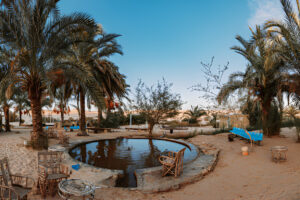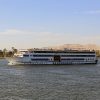Located in Egypt’s Western Desert, Siwa Oasis is one of the most unique and remote destinations in the country. Known for its ancient history, striking landscapes, and vibrant cultural traditions, Siwa has long been a place of refuge and mystery. It is a peaceful escape from the bustle of Egypt's larger cities and offers travelers a chance to experience the country's deep cultural roots, natural beauty, and quiet desert life.
Geography and Location
Siwa Oasis is situated approximately 700 kilometers west of Cairo, near the border with Libya. It is surrounded by vast stretches of desert, making it one of Egypt's most isolated oases. Despite its remote location, Siwa is a fertile patch of land, with numerous springs and salt lakes that sustain the local population. The oasis spans an area of about 80 kilometers long and 20 kilometers wide, making it one of Egypt’s largest and most important oases in the Western Desert.
The landscape of Siwa is characterized by towering sand dunes, salt lakes, and lush palm groves. The most famous natural feature of Siwa is the Siwa Salt Lake, a large saltwater lake where visitors can float just like in the Dead Sea due to its high salt content. The surrounding desert dunes and verdant groves make Siwa a haven for nature lovers, photographers, and those seeking tranquility.

A Place of Ancient History and Mysticism
Siwa has a rich history that dates back thousands of years. The oasis was inhabited by Berber-speaking people long before the advent of Islam, and its isolation has helped preserve its unique cultural and historical heritage.
One of the most famous historical sites in Siwa is the Temple of the Oracle of Amun at the Amun Temple. The temple is famous for its association with the Greek Pharaoh Alexander the Great, who visited Siwa in 332 BCE to consult the oracle. According to ancient accounts, Alexander was confirmed as the legitimate son of Amun by the oracle, solidifying his divine status. The temple ruins, located at the edge of the Siwa Oasis, include impressive stone structures and remnants of ancient inscriptions.
Siwa also has significant historical and archaeological value from earlier periods. The Shali Fortress is another important site in the oasis, constructed from mud bricks around the 13th century. The fortress was once the center of Siwa’s administration and defense, and visitors can explore its narrow passages and climb its towers for panoramic views of the oasis.
Siwa’s Unique Culture and Traditions
Siwa is home to the Siwan people, an ethnic group of Berber descent. The Siwan community has managed to preserve its distinct cultural traditions, language, and customs over the centuries, despite the influence of neighboring regions and civilizations.
The Siwan dialect, a variety of the Berber language, is still widely spoken by locals. Many Siwans continue to follow traditional ways of life, including farming and handicrafts. The local population is known for its warm hospitality, and visitors to the oasis often feel like they are stepping back in time to experience a simpler way of life.
One of the most significant traditions in Siwa is its architecture, particularly the Shali village. The old village was constructed from a unique mixture of salt and mud bricks, which helped to protect the buildings from the harsh desert climate. Today, the remains of Shali village stand as a symbol of Siwa’s heritage and resilience, with its crumbling structures and narrow streets offering a glimpse into the past.
Siwan cuisine is also deeply rooted in the oasis’s traditions. The food is made from locally grown ingredients, such as dates, olives, and figs, and is often characterized by simple, hearty dishes. A traditional Siwan meal might include khamsa, a bread made from wheat and barley, and tagine, a slow-cooked stew of meat and vegetables.
Natural Wonders and Outdoor Activities
Siwa’s natural beauty is one of the main attractions for visitors. The oasis is home to several natural springs, the most famous of which is the Cleopatra Spring. According to local legend, Cleopatra herself bathed in the spring’s waters, which are believed to have healing properties. Visitors can swim in the clear, fresh waters of the spring, surrounded by lush vegetation and tall palm trees.
In addition to the natural springs, Siwa is also famous for its salt lakes and desert dunes. The Siwa Salt Lake is a popular spot for swimming and relaxing, while the desert surrounding Siwa offers opportunities for adventure activities such as sandboarding, jeep safaris, and camel treks. The vast expanse of the Sahara Desert, with its golden sand dunes and deep blue skies, is a captivating setting for outdoor enthusiasts.
The Great Sand Sea lies to the south of Siwa and is one of the largest sand dune fields in the world. It offers the chance to explore the surreal desert landscape by jeep or camel, providing a sense of adventure and serenity in the heart of the desert. The endless dunes, combined with the isolation of the oasis, create a magical
atmosphere that makes Siwa one of the most enchanting destinations in Egypt.
Eco-Tourism and Sustainable Development
Siwa is increasingly becoming a popular destination for eco-tourism, with a growing number of visitors seeking to experience its unique landscape and culture in an environmentally responsible way. Local initiatives aim to preserve the area’s natural resources and cultural heritage while promoting sustainable tourism.
Many of the lodges and guesthouses in Siwa have adopted eco-friendly practices, such as using solar power, recycling water, and growing their own food. Travelers are encouraged to respect the environment and local customs by minimizing their impact on the fragile desert ecosystem.
Conclusion
Siwa Oasis is a magical destination that combines history, culture, and nature in one stunning location. With its ancient temples, desert landscapes, and timeless traditions, Siwa offers a unique and peaceful retreat from the modern world. Whether you’re exploring the ruins of the Oracle Temple, relaxing in Cleopatra’s Spring, or simply enjoying the silence of the desert, Siwa is a place where visitors can reconnect with both nature and history in a truly unforgettable way. It is one of Egypt’s hidden treasures, offering a profound experience of the country’s diverse and rich heritage.






